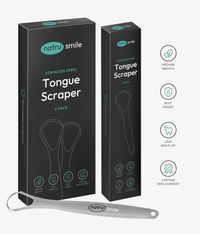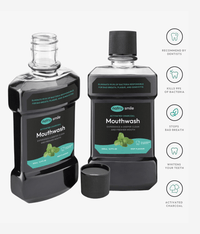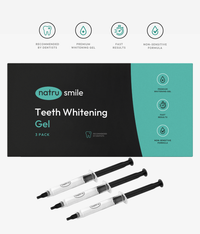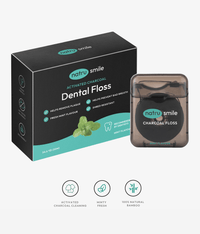
All products are certified by dental expert Dr. Greg Grillo
An exposed tooth root leads to a range of uncomfortable and, at times, painful sensations. In this all-encompassing guide, we aim to provide you with valuable information on the possible causes and symptoms of exposed tooth roots, present a variety of treatments to resolve this dental issue, and offer suggestions for preventing exposed tooth roots in the future. Furthermore, we'll discuss when to consult your dentist to ensure timely treatment and maintenance of good oral health.
By the end of this guide, you'll have a comprehensive understanding of the factors contributing to exposed tooth roots, the signs to watch for, and the best options for treating the condition. You'll also learn how to minimize the risk of experiencing exposed tooth roots and ensure that your teeth remain healthy and intact.
So, let's delve into the world of exposed tooth roots and equip ourselves with the necessary knowledge to combat this dental issue!
What Causes Exposed Tooth Roots?
There are a variety of factors that lead to the development of exposed tooth roots. We'll explore these factors in more detail to help you understand and potentially prevent or address the problem. The most common causes of exposed tooth roots are:
-
Gum Recession: One of the most frequent reasons behind exposed tooth roots is gum recession. This transpires when the gums, composed of soft tissue that protects and supports teeth, slowly retreat, leaving the tooth roots exposed. This condition not only heightens tooth sensitivity but also leads to decay and other dental issues.
-
Gum Disease: Periodontitis, an advanced form of gum disease, refers to a severe gum infection that damages the soft tissue and bone supporting the teeth. If left untreated, periodontitis leads to gum recession and the exposure of tooth roots. Maintaining proper oral hygiene and visiting your dentist regularly helps prevent this condition.
-
Teeth Grinding: Also known as bruxism, teeth grinding often unconsciously occurs during sleep or periods of stress. This habit causes excessive wear on the teeth, leading to the gradual erosion of tooth enamel and eventually exposing the roots. In addition to gum recession, bruxism results in jaw pain, headaches, and other dental issues.
- Misaligned Teeth: When teeth are improperly aligned, they will experience uneven pressure during biting and chewing activities. This imbalance in forces leads to gum recession and root exposure over time. Orthodontic treatment options like braces or clear aligners help correct misaligned teeth and prevent further dental problems.
Understanding these causes and addressing them early on significantly decreases the likelihood of exposed tooth roots and helps maintain overall oral health.
Symptoms And Signs Of An Exposed Tooth Root
The primary and most common symptom of an exposed tooth root is tooth sensitivity. This is typically characterized by a sharp or throbbing pain when you consume hot, cold, sweet, or acidic foods and beverages. The discomfort may be intermittent or persistent, depending on the severity of the exposure. Besides tooth sensitivity, several other symptoms and indications of an exposed tooth root are:
-
Tooth Discoloration: The exposed root area may appear darker than the rest of your tooth. This phenomenon occurs because the outer enamel layer is not present on the root, exposing the darker dentin beneath it.
-
Gum Swelling Or Redness: The gum tissue surrounding the affected tooth may become swollen or appear redder than usual due to the exposure and potential associated inflammation.
-
Bleeding Gums: Exposed tooth roots make it more likely for you to experience gum bleeding during brushing or flossing, as the compromised gum tissue and tooth structure become more sensitive and prone to injury.
-
Visible Root: In some cases, you might be able to see the exposed root structure as the gum line recedes away from the tooth.
- Loose Tooth: Severe gum recession causes the tooth to feel loose within its socket due to the loss of supporting gum tissue and bone.
It's crucial to pay attention to these symptoms and seek dental advice if you suspect that you may have an exposed tooth root. Early detection and intervention help preserve your dental health and prevent further complications.
Exposed Tooth Root Treatments: An In-Depth Look
When it comes to exposed tooth root treatments, your dentist will first diagnose the issue and determine the underlying cause to recommend a suitable treatment plan. Here, we'll delve into some common treatments for various causes of exposed tooth roots:
Gum Recession
In instances where gum recession is the cause of exposed tooth roots, your dentist's suggested treatment will depend on the severity of the issue. With mild gum recession, lifestyle changes may be all that's necessary to prevent further complications. However, in more severe cases, dental procedures might be required. such as:
Dental Crown
A dental crown is a custom-made cap that's placed over the entire tooth to protect it from additional damage, while also restoring its appearance. Crowns are made of various materials, such as porcelain, ceramic, or metal alloys.
Gingival Mask
A gingival mask, also referred to as a gum mask, is a removable prosthetic created from gum-colored materials. This mask is designed to cover the exposed root area, improving both the appearance of your teeth and minimizing sensitivity.
Gum Graft
During a gum graft procedure, a piece of tissue – typically taken from the roof of your mouth – is attached to the receding gum area. This serves to cover the exposed tooth root, facilitate proper healing, and prevent further damage.
Flap Surgery
In flap surgery, a periodontist creates a small incision along the gum line and carefully lifts it back to thoroughly clean the area – including your tooth root. Afterward, the gum is sutured back into place, effectively covering the exposed root.
Gum Disease
If gum disease is the culprit behind your exposed tooth root, your dentist may recommend the following treatments:
Dental Scaling
During dental scaling, a dental professional thoroughly removes plaque and tartar buildup from the tooth surface as well as from below the gum line. This meticulous cleaning process is crucial for maintaining healthy gums.
Root Planing
Root planing is a procedure that smoothes the rough surfaces of the tooth root, helping to prevent bacteria from accumulating in the area and promoting gum healing.
Periodontal Surgery
In severe cases, periodontal surgery may become necessary. This type of surgical intervention removes infected tissue, repairs damaged bone, and aids in the regeneration of periodontal tissues.
Root Canal
When an exposed tooth root leads to severe pain or infection, a root canal treatment may be the best option. This procedure entails removing the infected pulp from the tooth's interior and sealing it to prevent future infections. While often associated with pain and botched procedures, root canals have a 98% success rate.
Teeth Grinding
For those who suffer from teeth grinding, dentists often recommend wearing a mouthguard during sleep. This dental appliance protects your teeth from further damage and mitigates any associated jaw discomfort.
Misaligned Teeth
Misaligned teeth may contribute to exposed tooth roots. To remedy this, your dentist may propose orthodontic treatments, such as:
Braces
Traditional braces consist of wires and brackets that work in tandem to gradually shift teeth into their correct positions over a set period.
Retainers
A retainer is a custom-made dental appliance typically used after braces are removed. This device helps maintain the new position of your teeth and prevent them from moving back to their previous alignment.
Invisible Aligners
Invisible aligners, such as Invisalign, are an alternative to traditional braces. These clear, plastic trays are custom-fit and designed to gradually move teeth into proper alignment through a series of progressive steps.
Tooth Removal
This technique involves removing one or more teeth to make room for others, thus resulting in a straighter smile. Your dentist may also suggest the use of braces or other orthodontic treatments to help align your teeth properly, as well as reshaping them if necessary.
Surgery
Bony irregularities or severe misalignment may require the removal of a small portion of the bone around a tooth to reposition it in its proper place. This procedure is called orthognathic surgery.
How To Prevent The Possibility Of Exposing Roots
To minimize the chances of having exposed tooth roots, it's essential to practice good oral hygiene and adhere to specific preventative measures. Here are some key steps you should follow:
Get Regular Dental Checkups
Regular dental checkups are crucial for maintaining proper oral health. By visiting your dentist every six months for checkups and cleanings, you allow them to detect and address any oral health issues early on, including gum disease and tooth decay, which could lead to exposed tooth roots if left untreated.
Avoid Tobacco
Tobacco use significantly raises the risk of gum disease by weakening your immune system and hampering your body's ability to heal infected gums. Consequently, the likelihood of developing exposed tooth roots also increases. Therefore, it's essential to quit smoking or using other tobacco products to maintain healthy gums.
Brush And Floss Your Teeth
Proper oral hygiene is the foundation of good overall mouth health. Make sure to brush your teeth at least twice a day using fluoride toothpaste and a soft-bristled toothbrush. Additionally, floss daily to remove any trapped food particles and plaque buildup between teeth and along the gumline that brushing alone cannot remove. This daily effort helps prevent gum disease and tooth decay, both of which contribute to exposed tooth roots.
Avoid Aggressive Brushing
While brushing your teeth is crucial, it's also vital to ensure you're doing so correctly. Use a soft-bristled toothbrush and gentle, circular motions to clean your teeth and gumline thoroughly. Avoid aggressive brushing, as it causes your gums to recede, leading to exposed roots and creating areas for bacterial accumulation.
Avoid Teeth Grinding
Teeth grinding, or bruxism, puts excessive pressure on your teeth and may cause them to crack, chip, or wear down. This pressure also leads to gum recession and, subsequently, exposed tooth roots. If you believe you might be grinding your teeth unconsciously, particularly during sleep, talk to your dentist about obtaining a custom-fitted mouthguard or exploring other appropriate solutions to protect your teeth, prevent exposed roots, and alleviate any associated discomfort.
Exposed Vs. Nonexposed Roots: Understanding The Differences And Risks
A crucial aspect to consider when discussing black dots or dental issues, in general, is the difference between exposed and nonexposed tooth roots. Here, we'll explain the difference between the two, the increased risks associated with exposed roots, and the best practices for maintaining oral health in either situation.
Exposed Tooth Roots
An exposed tooth root is one where the gums have receded or worn away, and the root is left without the protection of gum tissue or tooth enamel. Without this natural barrier, the roots are more susceptible to damage, decay, and infections. There are various reasons a tooth root may become exposed, including:
- Gum recession due to aging
- Periodontal disease
- Overly aggressive tooth brushing
- Teeth grinding (bruxism)
- Trauma or injury to the tooth
Nonexposed Tooth Roots
Nonexposed tooth roots, on the other hand, remain comfortably nestled within the gum tissues and are shielded by the strength of tooth enamel. This natural protection is vital for a tooth's health, as it keeps harmful bacteria, plaque, and infection at bay.
When To See A Dentist
It's important to know when to consult with a dental professional, especially when dealing with concerning symptoms. If you find that you're experiencing persistent tooth sensitivity, discomfort, or other signs that may indicate an issue such as an exposed tooth root, it is crucial to visit your dentist promptly for an evaluation and proper treatment. Taking this step helps prevent more severe oral health problems from developing and protects the overall health and well-being of your teeth.
Early intervention is key to maintaining good oral health, as it leads to more effective treatment options and minimizes the risk of additional complications. Don't hesitate to make an appointment with your dentist if you suspect that there's a problem with your teeth that needs attention. It's always better to be proactive when it comes to your dental health. The sooner you address any concerns, the better the chances are of preventing long-term damage and ensuring the health and integrity of your teeth.
Addressing Root Exposure And Maintaining Oral Health
When dealing with an exposed tooth root, it's essential to identify the underlying cause and address it promptly. If the issue is left untreated, it may lead to various oral health complications, such as tooth decay, gum disease, and tooth sensitivity. Following your dentist's recommended treatment plan is effective in safeguarding your oral health and preventing any further complications.
Some tips for maintaining oral health and minimizing the risks of root exposure include:
- Practicing proper oral hygiene (brushing, flossing, and using mouthwash daily)
- Visiting the dentist for regular check-ups and professional cleanings
- Avoiding tobacco products
- Being mindful of tooth grinding or clenching, and seeking appropriate treatment if needed
In conclusion, understanding the differences between exposed and nonexposed tooth roots is vital for preventing dental problems and maintaining good oral health. Remember this when considering potential causes and treatments for black dots on teeth to ensure you make informed decisions and obtain the best dental care possible.
Even with all of this information, you may still have questions. Luckily, we’ve answered some of the most common ones below.
Are Exposed Tooth Roots Bad?
Exposed tooth roots occur when the gums recede, exposing part of your tooth’s root. This is caused by several factors such as periodontal disease or aggressive brushing habits. While not ideal, exposed tooth roots don't necessarily mean you're in trouble – but they should still be addressed promptly to prevent further damage.
Are Exposed Tooth Roots Common?
Exposed tooth roots are uncommon, meaning they occur only in specific situations. They are most often seen when gums have receded due to periodontal disease, or gum disease. In some cases, the recession of the gums is caused by aggressive brushing and flossing habits. Additionally, genetics play a role in some cases of exposed tooth roots.
Is An Exposed Tooth Root Dangerous?
Exposed tooth roots are a cause for concern. While they are not always dangerous, leaving them untreated leads to further damage and even tooth loss. Exposed tooth roots need to be examined by a qualified dentist to determine the severity of the problem and whether further treatment is necessary.
Will An Exposed Tooth Root Hurt?
Exposed tooth roots may be extremely uncomfortable and even painful. The exposed root is highly sensitive due to its lack of protective enamel, so it’s important to take steps to protect the area from further damage. This includes avoiding high-impact foods or activities that put pressure on the exposed root. If you are experiencing pain or discomfort, contact your dentist for a professional diagnosis and treatment plan.
How To Treat An Exposed Tooth Root Naturally
There are several natural remedies available to help alleviate symptoms associated with exposed tooth roots.
The first step when treating exposed tooth roots is identifying the underlying cause. Some common causes include poor oral hygiene habits such as inadequate brushing and flossing or gum disease. It is important to address any possible contributing factors before attempting to treat the issue with natural remedies.
Once you have identified the source of your exposed tooth root problem, you must maintain and improve your dental hygiene. This includes brushing twice a day with fluoride toothpaste, flossing daily, and rinsing with an antiseptic mouthwash. Regular visits to the dentist are also important for keeping teeth healthy and free from decay or oral infection.
In addition to addressing the underlying causes of exposed tooth roots and improving your oral hygiene routine, several natural remedies help reduce discomfort associated with the condition. These include:
-
Aloe Vera: Applying aloe vera directly to the affected area helps reduce inflammation while soothing any pain or discomfort in the gums surrounding the exposed root.
-
Oil Pulling: This Ayurvedic practice involves swishing sesame, coconut, or sunflower oil in your mouth for up to 20 minutes. It is believed to draw out toxins and reduce inflammation in the gums, helping to reduce pain associated with exposed tooth roots.
- Tea Tree Oil: Applying tea tree oil directly onto the affected area helps soothe any discomfort caused by exposed tooth roots. It is also antibacterial and antifungal, making it ideal for relieving infection and reducing inflammation around the affected area.
By addressing the underlying cause of exposed tooth roots and incorporating natural remedies into your routine, you help alleviate any discomfort associated with the condition.
What Does An Exposed Tooth Root Look Like?
An exposed tooth root looks like a visible portion of the tooth under the gum line. The root may be partially covered in gum tissue but is most often fully visible. It may appear as an ivory-colored or yellowish protrusion from beneath the gums and range in size from a grain of rice to a small pea. Look at the images included earlier in the article or do your research online for a visual example for comparison.
Can A Tooth Be Saved If The Root Is Exposed?
Exposed tooth roots are often saved, depending on the cause. If the root has been exposed due to gum recession caused by periodontal disease or poor oral hygiene, then a dental professional may recommend a soft tissue graft to cover and protect it. Root canal therapy may also be recommended if the root is damaged.
Wrapping Up
An exposed tooth root is a painful and unsightly problem that is often caused by receding gums, periodontal disease, or other dental issues. Fortunately, there are several treatments available to address this condition, including gum grafts, bone grafts, crown lengthening procedures, and more. These treatments help restore the appearance of your smile while also helping to protect the health of your teeth and gums. With regular check-ups and good oral hygiene practices at home, you will reduce your risk of developing exposed tooth roots in the future.












